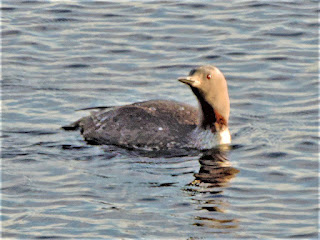NATURE MONCTON INFORMATION LINE, September 13, 2021 (Monday)
To respond by email, please address your message to
the information line editor, nelsonpoirier435@gmail.com
Please advise the editor at nelsonpoirier435@gmail.com if any errors are noted in wording
or photo labelling.
For more information on Nature Moncton, check the
website at www.naturemoncton.com
Edited by: Nelson Poirier nelsonpoirier435@gmail.com
Transcript by Susan Richards susan_richards@rogers.com
Info Line #: 506-384-6397 (384-NEWS)
**Pat
MacLauchlan came across a young buck WHITE-TAILED DEER showing some
unusual white spotting arrangements that he has never seen before. Pat is an experienced outdoor person and
suspect that he has seen many White-tailed Deer.
The
only weak explanation I can offer is an unusual manifestation of piebald. Sometimes wounds will heal over with new hair
coming in white, but think this pattern rules out this possibility.
**Sue and
Fred Richards came across the striking BEDSTRAW HAWK-MOTH aka GALLIUM SPHINX
caterpillar on Sunday. The colour can be variable, but the general pattern is
always the same with the signature red horn over the tail. It
appeared to be trying to dig its way into the earth they had delivered for their
greenhouse. There were still piles they hadn't raked up and it was in a
pile on the grass near their working area. Susan put it in the caged garden
after photographing it.
No doubt, it was preparing to go into its pupal stage in a cocoon for
the winter. If this is kept in an enclosed area such as an aquarium and in the
cold, the beautiful adult moth will emerge in the spring. We don’t tend to see
the adults often as they are not attracted to lights like so many other moths.
Am attaching a photo of the large beautiful adult I got a few years ago after
housing the cocoon for the winter and the emerged adult beside it.
**Maureen Girvan visited the BOUCTOUCHE DUNE BOARDWALK on Sunday
to leave a photo of the boardwalk and a BALD EAGLE keeping a watch on
the goings-on.
**Yolande Leblanc in Memramcook comments she still has 2 RUBY-THROATED HUMMINGBIRDS but with 3 feeders out, still wonders how some yards can have several coming to a feeder, when she always gets the combatant ones that seem to think the 3 feeders are solely for a chosen few.
**Aldo
Dorio photographed a RED-THROATED LOON on Hay Island on Sunday. It’s still showing the brick-red throat/neck
patch of breeding plumage and holding its bill slanted upward as it always does
and helps to identify its silhouette that we get to see in ice-free water off
our coastline in winter plumage.
**Gabriel
Gallant found some HEDGEHOG MUSHROOMS.
This mushroom happens to be classed as a choice edible with a fruity
odor. It is very easy to recognize with
its soft, toothlike undersurface and a pale brown cap. It is also known as SWEET TOOTH MUSHROOM.
**Rosita
Lanteigne sends some photos of mushrooms wondering about identity. It’s a BOLETE and sure looks to me
like the KING BOLETE (BOLETUS EDULIS) which is actually a
choice edible. The thing to really look
for is a pattern that looks like a fishing net imprint on the stalk for a few inches
just below where it joins the cap. I
think I can see it in 2 photos and the area is arrowed. These mushrooms can grow surprisingly large
and are often found associated with conifers.
The other mushroom that has this net pattern is the BITTER
BOLETE. It’s a smaller and more
white-to- pale-pink underneath. It’s not
toxic but tastes very bitter. You can
actually safely take a small piece of a specimen, taste it, and spit it out. If it’s a Bitter Bolete, you’ll quickly know!
Google
has a firehose of information on the King Bolete. It is sometimes seen in grocery stores where
it is called PORCINI with the same scientific name Boletus edulis.
As
always, be absolutely confident of your identification when using wild
mushrooms as edibles. There are a lot of
great ones out there with very unique flavours, but there are species out there
to avoid ingesting.
Nelson Poirier,
Nature Moncton













